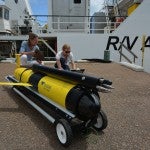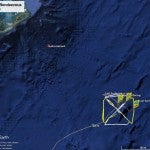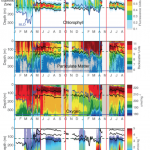Until the COVID-19 pandemic and shark attacks intervened, the MAGIC Lab was conducting a 2-year field program – the Biological Production and Exports (BPE) experiment – funded jointly by NSF and the Simons Foundation International. This experiment is using gliders in combination with ship-based measurements to help answer long-standing questions about the biological carbon pump in the Sargasso Sea.
Simply put, the biological carbon pump is a pathway by which carbon can be sequestered, or “stored,” deep in the ocean. Understanding this process becomes increasingly important as we continue to face climate change and rapidly increasing levels of atmospheric carbon dioxide. Phytoplankton (microscopic ocean plants) are the drivers of the biological carbon pump, and factors that impact their growth is an important part of this study. These tiny plants may seem foreign, but they function largely the same way as the grass and trees do on land; they need carbon dioxide, sunlight, water, and nutrients to photosynthesize and grow. The distribution of phytoplankton in the water column is governed by these needs. For example, sunlight only reaches into the surface of the ocean, this limits where photosynthesis can take place and therefore where the phytoplankton can survive.
Much of what we know about phytoplankton in the Sargasso Sea comes from the Bermuda Atlantic Time Series (BATS), a program that has been taking monthly ship based measurements in this area for the past 30 years. In the Sargasso Sea, nutrients can be found deep in the water column but in the surface water nutrients are very low; this limits phytoplankton growth. Phytoplankton rely on sporadic events in which nutrients mix upward into the surface waters. Strong seasonal variability further complicates this relationship. The ocean is different in the winter and early spring than the summer and early fall. In the winter and early spring, the surface of the ocean cools and storms roll through; this promotes mixing throughout the top layer of the ocean. Mixing allows nutrients, which are more plentiful deep in the ocean, to be swept upward to the surface ocean where they can be used by phytoplankton. In the summer, the ocean becomes strongly stratified with a big density difference between the surface and deeper water. This stratification results in fewer deep nutrients mixing up to the surface, therefore resulting in less phytoplankton growth.
Like plants on land, phytoplankton form the base of the marine food web. Many are grazed by larger organisms, their remains are broken down and re-mineralized – this includes the carbon that was used to grow, this carbon is free to go on to be used by other phytoplankton or enter the atmosphere. Unlike plants on land, some phytoplankton remains sink deep into the ocean taking the carbon that they used during photosynthesis with them. That carbon is then sequestered deep in the ocean and won’t be going into the atmosphere anytime soon. This is the biological carbon pump. Through photosynthesis carbon is taken up by phytoplankton, which eventually sinks deep into the ocean, taking the carbon with them.
Phytoplankton growth and the biological carbon pump are complex – they involve a complicated web of biological, chemical, and physical processes. While the monthly BATS data has provided great insight to many of these processes, there are some questions that we still have not been able to address – it is likely that the monthly shipboard measurements are missing important events that happen on shorter time scales. This is where gliders come in.
Gliders are excellent instruments for collecting high-resolution data because they can collect oceanographic data 24 hours a day, for months at a time. Scientific sensors for autonomous vehicles like gliders are improving every year and our gliders carry a suite of specialized and leading-edge sensors to help us answer the specific questions of the BPE experiment. All of our gliders have a Conductivity-Temperature-Depth (CTD) sensor, oxygen optode, and fluorometer. The CTD records conductivity, temperature, and depth (pressure) of the water. We use these values to calculate salinity and density of the water as well. The oxygen optode that tells us how much oxygen is in the water and the fluormeter gives us an approximation for phytoplankton. Other specialized sensors that our gliders carry include a Submersible Underwater Nitrate Analyzer (SUNA) – this instrument measures nutrients in the water, a MicroRider – this instrument measures turbulence and mixing throughout the water column, and a Photosynthetically Active Radiation (PAR) sensor that measures light. These sensors allow us to look at individual pieces that influence phytoplankton production and the biological carbon pump.
Our goal for this experiment is to use these glider-based measurements in combination with the monthly ship based measurements to better understand the biological carbon pump in the Sargasso Sea on shorter time scales. To accomplish this and capture the seasonal changes we need to have two gliders flying at our study site (about 60 miles southeast of Bermuda) throughout the entire year, not a trivial task. We have faced a number of challenges in collecting this data over the past 12 months including, shark hits, difficulties with new sensors, and now some COVID-19 related delays. But, we have also been able to celebrate a number of successes and collaborations. We engineered a solution to glider flight instabilities caused by the MicroRider being mounted “piggy-back” on the glider. We worked with sensor manufactures to solve and prevent instrument malfunctions. We collaborated with Teledyne Webb Research (the company that manufactures the gliders) and Rutgers University Center for Ocean Observing and Leadership when their glider, Silbo, made a 4-month pit stop at the BPE study site to collect data with our gliders. Silbo is part of a five-year global oceanographic investigation called the Challenger Mission and stopped by after flying across the Atlantic Ocean from the Canary Islands to the Virgin Islands and then north toward Bermuda. The data that Silbo collected will supplement the data collected by the MAGIC gliders and in return the MAGIC gliders will provide Silbo with sensor calibration measurements.
- MAGIC Program Leader Ruth Curry and Research Technician Cordielyn Goodrich conduct a dockside check on the glider Jack.
- In October, two of the MAGIC program gliders, Anna and Minnie, were joined by a third glider, Silbo, which was returning to port after completing the final leg of a five-year global oceanographic investigation called The Challenger Mission. Led by scientists from Rutgers University in New Jersey and Teledyne Webb Research, The Challenger Mission aims to demonstrate the value of robotic vehicles to improving regional and global weather forecasting models. Silbo’s measurements will be added to existing data collected by the MAGIC gliders and help provide scientists with a larger picture of circulation patterns in the ocean.
- Time series of glider measurements from January 2017 to August 2018 and the layered framework for evaluating seasonal evolution of the biological carbon pump.




